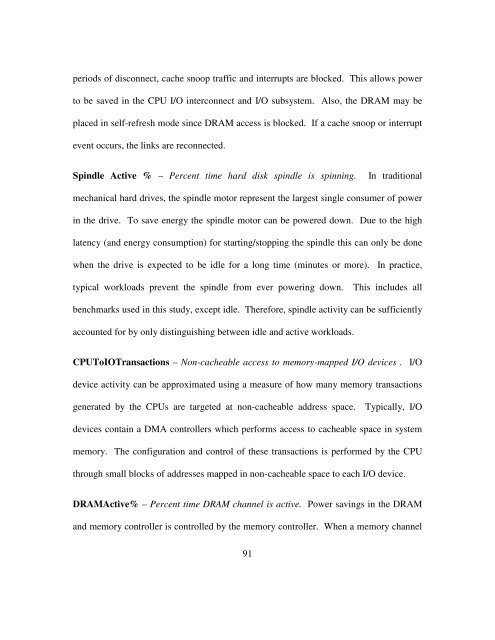Copyright by William Lloyd Bircher 2010 - The Laboratory for ...
Copyright by William Lloyd Bircher 2010 - The Laboratory for ...
Copyright by William Lloyd Bircher 2010 - The Laboratory for ...
Create successful ePaper yourself
Turn your PDF publications into a flip-book with our unique Google optimized e-Paper software.
periods of disconnect, cache snoop traffic and interrupts are blocked. This allows power<br />
to be saved in the CPU I/O interconnect and I/O subsystem. Also, the DRAM may be<br />
placed in self-refresh mode since DRAM access is blocked. If a cache snoop or interrupt<br />
event occurs, the links are reconnected.<br />
Spindle Active % – Percent time hard disk spindle is spinning. In traditional<br />
mechanical hard drives, the spindle motor represent the largest single consumer of power<br />
in the drive. To save energy the spindle motor can be powered down. Due to the high<br />
latency (and energy consumption) <strong>for</strong> starting/stopping the spindle this can only be done<br />
when the drive is expected to be idle <strong>for</strong> a long time (minutes or more). In practice,<br />
typical workloads prevent the spindle from ever powering down. This includes all<br />
benchmarks used in this study, except idle. <strong>The</strong>re<strong>for</strong>e, spindle activity can be sufficiently<br />
accounted <strong>for</strong> <strong>by</strong> only distinguishing between idle and active workloads.<br />
CPUToIOTransactions – Non-cacheable access to memory-mapped I/O devices . I/O<br />
device activity can be approximated using a measure of how many memory transactions<br />
generated <strong>by</strong> the CPUs are targeted at non-cacheable address space. Typically, I/O<br />
devices contain a DMA controllers which per<strong>for</strong>ms access to cacheable space in system<br />
memory. <strong>The</strong> configuration and control of these transactions is per<strong>for</strong>med <strong>by</strong> the CPU<br />
through small blocks of addresses mapped in non-cacheable space to each I/O device.<br />
DRAMActive% – Percent time DRAM channel is active. Power savings in the DRAM<br />
and memory controller is controlled <strong>by</strong> the memory controller. When a memory channel<br />
91




